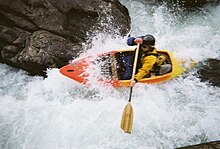Whitewater canoeing
This article includes a improve this article by introducing more precise citations. (August 2013) ) |

Whitewater canoeing is the sport of paddling a
Design

The canoe (or just 'boat') used in casual whitewater canoeing is different from those used in
History
Paddling on rivers, lakes and oceans is as old as the Stone Age. The raft, the catamaran, the canoe and the kayak evolved depending on the needs and environment of the indigenous peoples in different parts of the world. The modern day canoe most likely originated about 8,000 years ago.
The Greek, Herodotus, 484-425 BC, wrote in his travel diaries about boats with which merchandise was brought from Armenia to Babylon. The boats were made of a wooden framework that was covered with animal skins. Mules hauled the precious skins back to Armenia.
The Scot, John MacGregor published in 1866 the book A Thousand Miles in the Roy Rob Canoe. The timing was right and the book became a resounding success. With the Industrial Revolution leading to more leisure time in the middle of the 19th century, people in Europe started to enjoy floating down rivers in all kinds of contraptions taking in nature previously only available to a selected few.
Types
There are several 'sub-categories' in whitewater canoeing:
River running

River running can be thought of as a tour down a river, to enjoy the scenery as well as experiencing challenging whitewater. River running includes short day trips as well as longer multi-day trips. Multi-day canoe trips often entail the use of gear-toting rafts to allow a more comfortable experience without a heavily laden canoe although many people also carry their own gear in their canoes, especially on remote or wilderness sections of rivers. Canoes with gear typically are not commonly used above class IV whitewater without portages. Sometimes, open touring canoes with gear used on multi-day trips are fitted with fabric
Creeking

Slalom

Slalom is a technical competitive form of canoeing, and the only whitewater event to appear in the
Canoe freestyle

Playboating, also known as Playboating or Rodeo, is a more gymnastic and artistic kind of canoeing. While the other varieties of canoeing generally involve going from Point A to Point B, playboaters often stay in one spot in the river (usually in a hole, pourover or on a wave) where they work with and against the dynamic forces of the river to perform a variety of maneuvers. These can include surfing, spinning, and various vertical moves (cartwheels, loops, blunts, pistol and donkey flips, and many others), spinning the boat on all possible axis of rotation. More recently, aerial moves have become accessible, where paddlers perform tricks having gained air from using the speed and bounce of the wave. Canoes used for playboating generally have relatively low volume in the bow and stern, allowing the paddler to submerge the ends of the canoe with relative ease. Competitions for playboating or freestyle are sometimes called whitewater rodeo in the US, but more frequently just referred to as freestyle events in UK and Europe.
Techniques
Boofing
Boofing, in whitewater canoeing, refers to the raising of the canoe's bow during freefall, while descending a ledge, ducking behind a boulder, or running a waterfall. This technique is used to avoid submerging the bow of the canoe by ensuring it lands flat when it hits the base of the waterfall. The term is an onomatopoeia which mimics the sound that is usually created when the hull of the canoe makes contact with water at the base of the waterfall.
Another type of boof is the "rock boof" which is a move that uses a glancing impact with a boulder at the top of a ledge to bounce the boater over a downstream feature, often finished with a mid-air eddy turn. Rock boofs result in sounds both at the top of the drop (boat impacting rock) and the bottom (boat bellyflopping into the water).
Bracing
Another technique used to prevent the bow of the canoe from submerging. The bowsman uses his paddle like an outrigger held horizontal to the rivers surface. Used mostly to limit the amount of water the canoe takes in during running rapids.
Lining
Some rapids and rock gardens are navigatable when no-one is in the canoe. A line is attached to the canoe, it must be centre lined to the canoes axis and the canoer, on shore, simply allows the canoe to run the rapids empty while reeling in or reeling out rope as necessary.
Carry
Sometimes the only way to get over an obstacle, like a beaver dam or a shallow rock ledge, is to get out of the canoe and lift it or drag it over.
One Man
To keep the bow as high as possible sometimes no weight in the front, no bowsman, works well.
See also
- Canoeing and kayaking at the Summer Olympics
- Freeboating
- List of whitewater rivers
- Whitewater recreation in British Columbia
References
External links
- Whitewater canoeing at Curlie
- River level Readings
